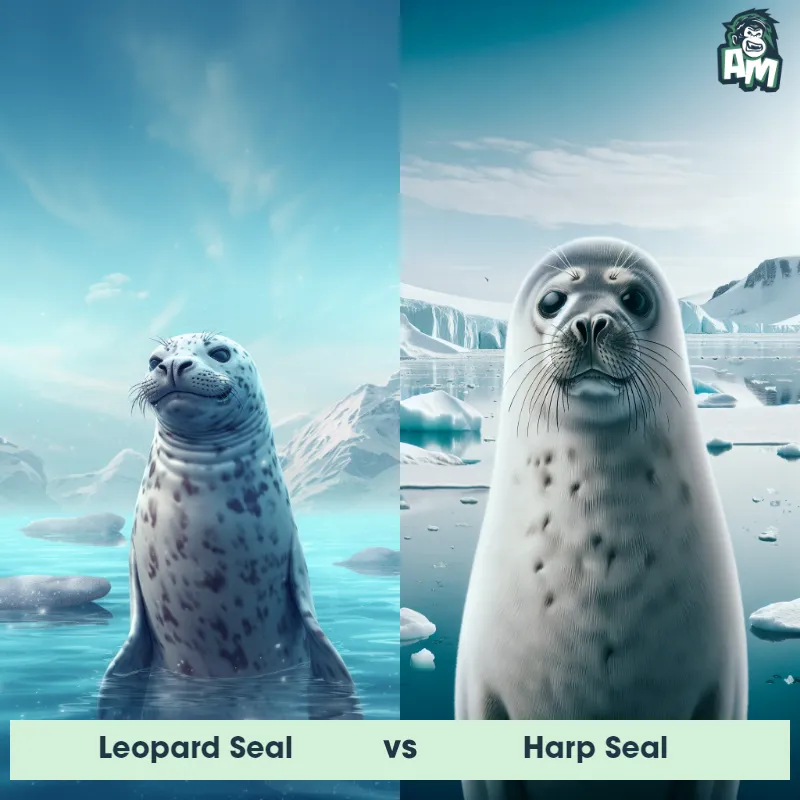The Harp Seal
The Harp Seal, also known as the Pagophilus groenlandicus, is a marine mammal found in the northern regions of the Atlantic Ocean and Arctic Ocean. They are known for their distinctive appearance, with a dark gray or black dorsal side and a white or light gray ventral side. As adults, they can grow up to 5 to 6 feet long and weigh between 220 to 290 pounds. Harp seals have a blubber layer that helps to insulate them in cold water and a thick coat of fur for additional warmth. They have large round dark eyes and their young, called "whitecoats" due to their pristine white fur, are born on pack ice.

| Harp Seal | |
|---|---|
| Size | 6.5 feet (1.98 meters) |
| Weight | 320 pounds (145 kilograms) |
| Speed | 12 mph (20 km/h) |
| Key Strength | Unknown |
| Biggest Weakness | Unknown |
| Scientific Name | Pagophilus groenlandicus |
| Family | Phocidae |
| Habitat | Marine (ocean) |
| Geography | North Atlantic and Arctic Oceans |
| Diet | Fish and crustaceans |
| Lifespan | 15 years - 25 years |

The Harp Seal
The Harp Seal, also known as the Pagophilus groenlandicus, is a marine mammal found in the northern regions of the Atlantic Ocean and Arctic Ocean. They are known for their distinctive appearance, with a dark gray or black dorsal side and a white or light gray ventral side. As adults, they can grow up to 5 to 6 feet long and weigh between 220 to 290 pounds. Harp seals have a blubber layer that helps to insulate them in cold water and a thick coat of fur for additional warmth. They have large round dark eyes and their young, called "whitecoats" due to their pristine white fur, are born on pack ice.
Fun Fact: Harp seals are excellent divers, capable of staying underwater for up to 15 minutes and reaching depths of 600 feet as they search for their prey, which mainly consists of fish and small invertebrates.
| Harp Seal | |
|---|---|
| Size | 6.5 feet (1.98 meters) |
| Weight | 320 pounds (145 kilograms) |
| Speed | 12 mph (20 km/h) |
| Key Strength | Unknown |
| Biggest Weakness | Unknown |
| Scientific Name | Pagophilus groenlandicus |
| Family | Phocidae |
| Habitat | Marine (ocean) |
| Geography | North Atlantic and Arctic Oceans |
| Diet | Fish and crustaceans |
| Lifespan | 15 years - 25 years |
Harp Seal Matchups
We use AI to simulate matchups between the Harp Seal and other animals. Our simulation considers size, strength, and natural predatory behaviors to determine the most likely outcome.

Can't find the Matchup you want?
Create Your Own MatchupHarp Seal: Diet, Predators, Aggression, and Defensive Behaviors
What do Harp Seals eat?
Harp seals primarily feed on a diet of fish, such as cod and herring, as well as crustaceans like shrimp and crabs. They are known to dive deep into the ocean in search of their prey, sometimes reaching depths of up to 1,000 feet.
Do Harp Seals have any predators?
Harp seals have a few natural predators, including killer whales and polar bears. Both of these predators are skilled hunters in the Arctic region and may target young, inexperienced, or injured seals as prey.
Are Harp Seals aggressive?
Harp seals are generally not considered aggressive animals. They are known for their curious and playful behaviors, especially among juveniles. However, they can display territorial behaviors when competing for food or mates.
Do Harp Seals fight?
Harp seals do engage in occasional fights, particularly during the breeding season when males compete for access to females. These fights typically involve displays of physical strength, vocalizations, and posturing rather than actual physical combat.
How do Harp Seals defend themselves?
Harp seals rely on their speed, agility, and camouflage to defend themselves from predators. They are excellent swimmers and can escape from danger by diving deep into the ocean or hiding in ice floes. Additionally, adult seals may use vocalizations to communicate distress or aggression.
What is the biggest weakness of Harp Seals in a fight?
One of the biggest weaknesses of Harp Seals in a fight is their lack of physical weapons or defenses. Unlike some other species of seals that have sharp teeth or claws, Harp Seals rely on their speed and agility to avoid conflict. This makes them vulnerable to larger, more aggressive predators that may overpower them in a fight.
Fun Fact: One fascinating aspect of Harp Seals is their vocalizations. They produce various sounds, ranging from the barking of adults to trills and chirping of young seals. These vocalizations help them communicate with each other, locate mates, and establish territories during the breeding season.
Fun Fact: The Harp Seal is known for its unique annual migration, in which they travel long distances to their breeding grounds on pack ice in the late winter and early spring. They undertake these arduous journeys, sometimes reaching over 2,000 kilometers, to give birth and raise their pups in a safe environment away from predators.











